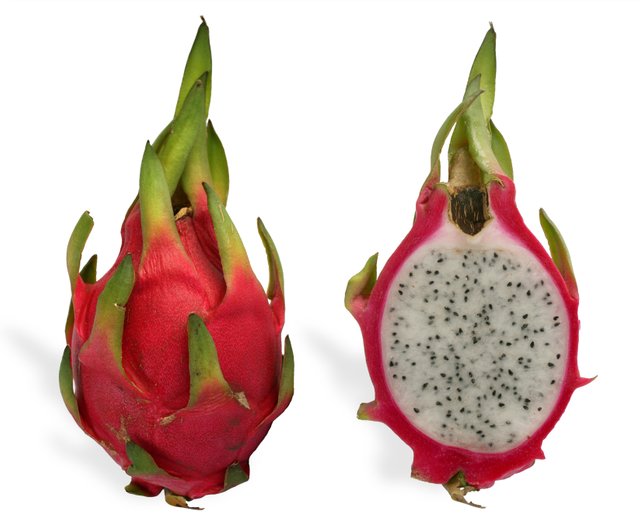
These fruits are purpolarlly known in English as "dragon fruit", reflecting its vernacular Asian names. The names pitahaya and pitaya derive from Mexico, and pitaya roja in Central America and northern South America, possibly relating to pitahaya for names of tall cacti species with flowering fruit. In China, the fruit is referred dragóng guǒ literally 'fire dragon fruit'.
Geography Of Dragon Fruit...
Pitahaya-producing cacti of the genus Hylocereus, originally native to a region including Mexico, Guatemala, Costa Rica, and El Salvador, were transplanted to Central America, probably by seed dispersal over centuries and by European explorers in the 16th century. The dragon fruit is cultivated in Southeast Asia, Florida, the Caribbean, Australia, and throughout tropical and subtropical world regions.
Dragon fruit -Varieties
https://images-na.ssl-images-amazon.com/images/I/61cjS4%2B4vVL.SL500_AC_SS350.jpg
Stenocereus fruit (sour pitayas) are a variety that is commonly eaten in the arid regions of the Americas. They are more sour and refreshing, with juicier flesh and a stronger taste. The sour pitaya or pitaya agria (S. gummosus) in the Sonoran Desert has been a relevant food source for indigenous peoples of the Americas. The Seri people of northwestern Mexico still harvest the fruit, and call the plant "thing whose fruit is sour". The fruit of related species, such as S. queretaroensis and the dagger cactus (S. griseus), are also locally important foods. The fruit of the organ pipe cactus (S. thurberi, called ool by the Seris) is the pitaya dulce "sweet pitaya". It still has a more tart aroma than Hylocereus fruit, described as somewhat reminiscent of watermelon; it has some uses in traditional medicine.
Dragon fruit Hylocereus
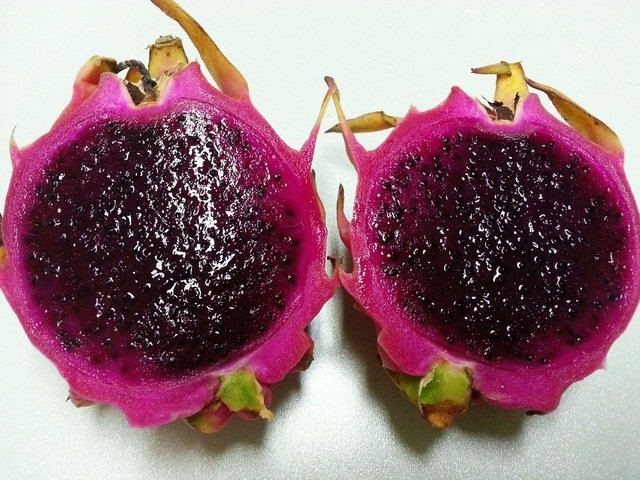
Ripe dragon fruit, Vietnam
Sweet pitahayas come in three types, all with leathery, slightly leafy skin:
Hylocereus undatus (Pitaya blanca or white-fleshed pitahaya) has pink-skinned fruit with white flesh. This is the most commonly seen "dragon fruit".
Hylocereus costaricensis (Pitaya roja or red-fleshed pitahaya, also known as Hylocereus polyrhizus) has red-skinned fruit with red flesh.
Hylocereus megalanthus (Pitaya amarilla or yellow pitahaya, also known as Selenicereus megalanthus) has yellow-skinned fruit with white flesh.
Early imports from Colombia to Australia were designated Hylocereus ocampensis (supposedly red fruit) and Cereus triangularis (supposedly yellow fruit). It is not quite certain to which species these taxa refer, though the former is probably the red pitaya.
The fruit usually weighs about 150 to 600 grams (5.3 to 21.2 oz) some may reach 1kilogram(2.2 lb).
How To Cultivate Dragon Fruit...
https://www.fast-growing-
trees.com/images/P/Dragon-Fruit-Cactus-450w.jpg
Seeds grow well in a compost or potting soil mix – even as a potted indoor plant. Pitaya cacti usually germinate after between 11 and 14 days after shallow planting. As they are cacti, overwatering is a concern for home growers. As their growth continues, these climbing plants will find something to climb on, which can involve putting aerial roots down from the branches in addition to the basal roots. Once the plant reaches a mature 10 pounds in weight, the plant may flower.[clarification needed]
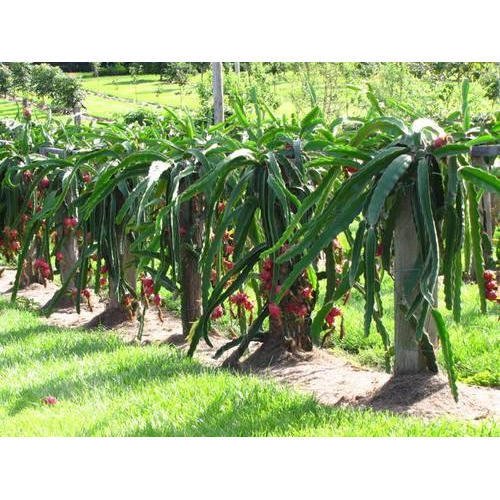
Pitaya flowers bloom overnight and usually wilt by the morning.They rely on nocturnal pollinators such as bats or moths for fertilization. Self-fertilization will not produce fruit in some species, and while cross-breeding has resulted in several "self-fertile" varieties, cross-pollinating with a second plant species generally increases fruit set and quality. This limits the capability of home growers to produce the fruit. However, the plants can flower between three and six times in a year depending on growing conditions. Like other cacti, if a healthy piece of the stem is broken off, it may take root in soil and become its own plant.
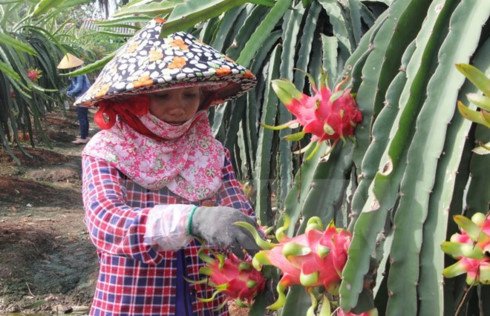
A dragon fruit field in China
After thorough cleaning of the seeds from the pulp of the fruit, the seeds may be stored when dried. Ideally, the fruit is unblemished and overripe.
The plants can endure temperatures up to 40 °C (104 °F) and very short periods of frost, but will not survive long exposure to freezing temperatures. The cacti thrive most in USDA zones 10–11, but may survive outdoors in zone 9a or 9b
Hylocereus has adapted to live in dry tropical climates with a moderate amount of rain. The dragon fruit sets on the cactus-like trees 30–50 days after flowering and can sometimes have 5-6 cycles of harvests per year. In numerous regions, it has escaped cultivation to become a weed and is classified as an invasive weed in some countries.
Seed oils
The fatty acid compositions of two pitaya seed oils were determined as follows:
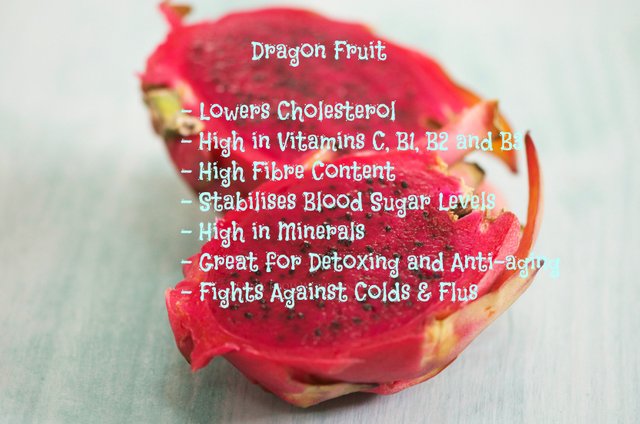
Hylocereus costaricensis (Red-fleshed pitaya) Hylocereus undatus (White-fleshed pitaya)
Myristic acid 0.2% 0.3%
Palmitic acid 17.9% 17.1%
Stearic acid 5.49% 4.37%
Palmitoleic acid 0.91% 0.61%
Oleic acid 21.6% 23.8%
Cis-vaccenic acid 3.14% 2.81%
Linoleic acid 49.6% 50.1%
Linolenic acid 1.21% 0.98%
Nocturnal pitahaya flowers
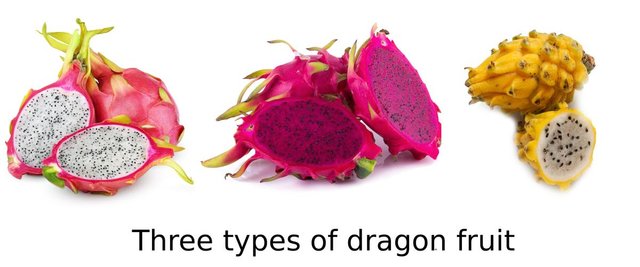
White pitahaya Hylocereus undatu
Yellow pitahaya Hylocereus megalanthus
’Red pitahaya, Hylocereus costaricensis
Pitaya fruit in various colors
Hylocereus has adapted to live in dry tropical climates with a moderate amount of rain. The dragon fruit sets on the cactus-like trees 30–50 days after flowering and can sometimes have 5-6 cycles of harvests per year. In numerous regions, it has escaped cultivation to become a weed and is classified as an invasive weed in some countries.
Dragon Fruit Juices
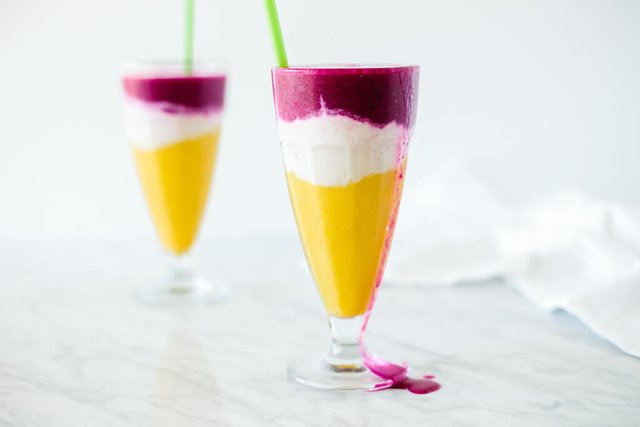
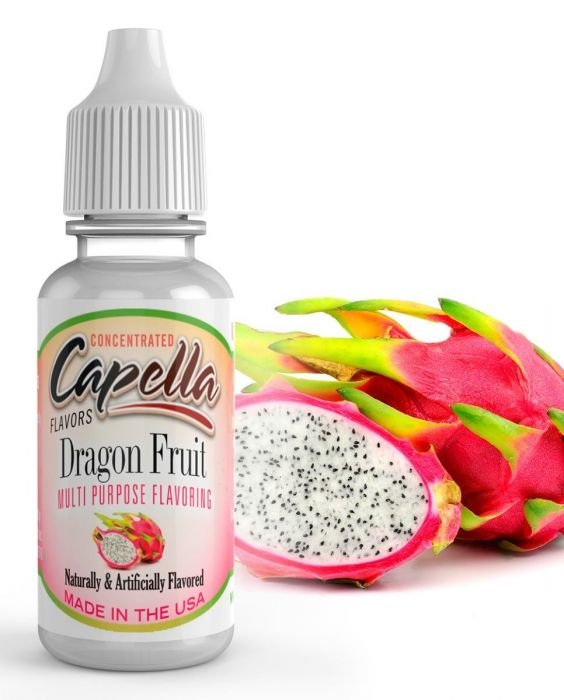
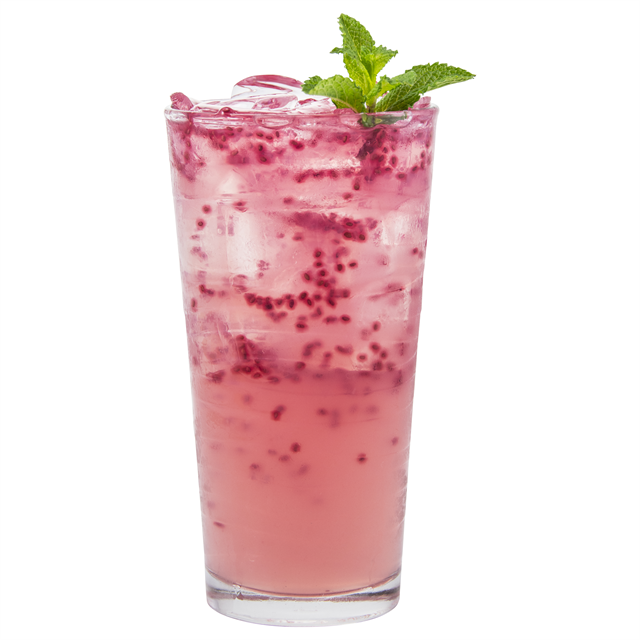
Overwatering or excessive rainfall can cause the flowers to drop and fruit to rot. Also, extended over-watering can cause maturing fruit to split on the branch. Birds can be a nuisance. The bacterium Xanthomonas campestris causes the stems to rot. Dothiorella fungi can cause brown spots on the fruit, but this is not common. Other fungi known to infect pitaya include Botryosphaeria dothidea, Colletotrichum gloesporioides and Bipolaris cactivora.
CHARACTERISTICS...
The fruit's texture is sometimes likened to that of the kiwifruit because of its black, crunchy seeds. The flesh is mildly sweet and low in calories. The seeds have a nutty taste and are rich in lipids. Dragon fruit is also used to flavor (and color) juices and alcoholic beverages, such as "Dragon's Blood Punch" and the "Dragotini". The flowers can be eaten or steeped as tea.
The red and purple colors of Hylocereus fruits are due to betacyanins, a family of pigments that includes betanin, the same substance that gives beets, Swiss chard, and amaranth their red color.
Dragon fruit (manufacturer entry)
Nutritional value per 100 g (3.5 oz)
Energy
268 kcal (1,120 kJ)
Carbohydrates
82.14 g
Sugars
82.14 g
Dietary fiber
1.8 g
Protein
3.57 g
Vitamins
(%DV)†Qty
Vitamin C
(11%) 9.2 mg
Minerals
Calcium
(11%) 107 mg
Sodium
(3%) 39 mg
Link to USDA Database entry
Units
μg = micrograms • mg = milligrams
IU = International units
†Percentages are roughly approximated using US recommendations for adults.
Source: USDA Nutrient Database
Nutrients

As the nutrient content of raw pitaya has not been thoroughly analyzed as of 2018, the US Department of Agriculture reports one limited entry from a manufacturer, showing that a 100 gram amount of pitaya contains 268 calories, 82% carbohydrates, 4% protein, and 11% of the Daily Value each for vitamin C and calcium (table).
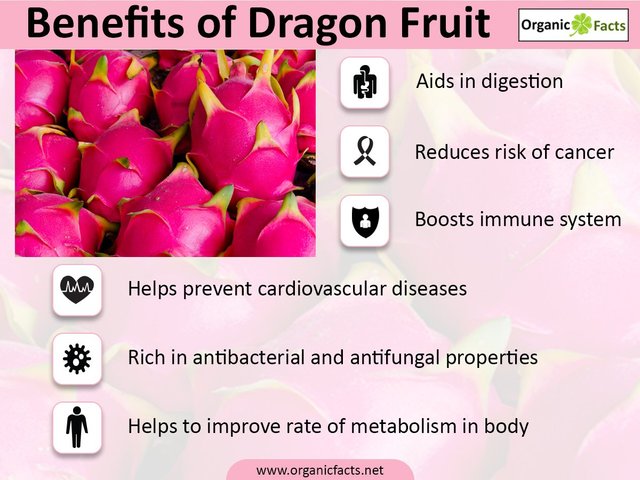
#introduceyourself/#introducemyself
The “introduceyourself/introducemyself” tag is for creating one introductory post that tells us about you. Users are encouraged to use this tag exclusively for that, and not to reuse it.
Downvoting a post can decrease pending rewards and make it less visible. Common reasons:
Submit
Hi! I am a robot. I just upvoted you! I found similar content that readers might be interested in:
https://en.wikipedia.org/wiki/Dragonfruit
Downvoting a post can decrease pending rewards and make it less visible. Common reasons:
Submit